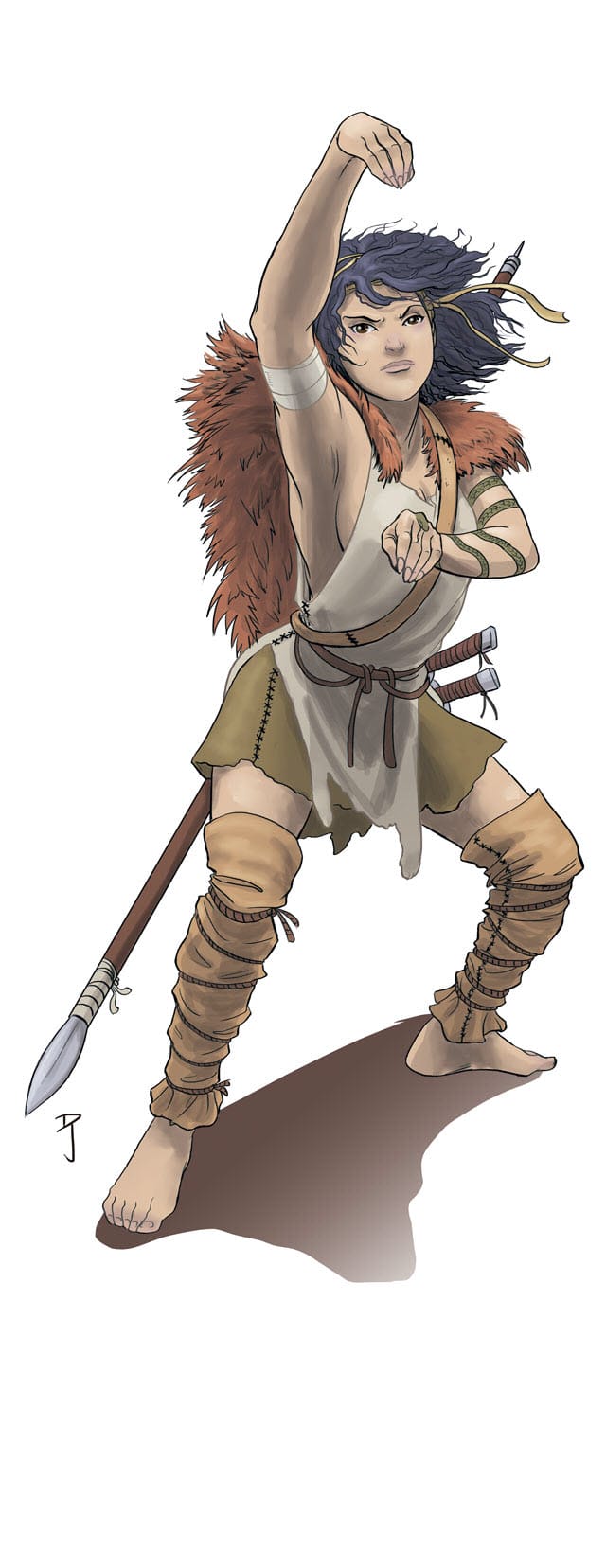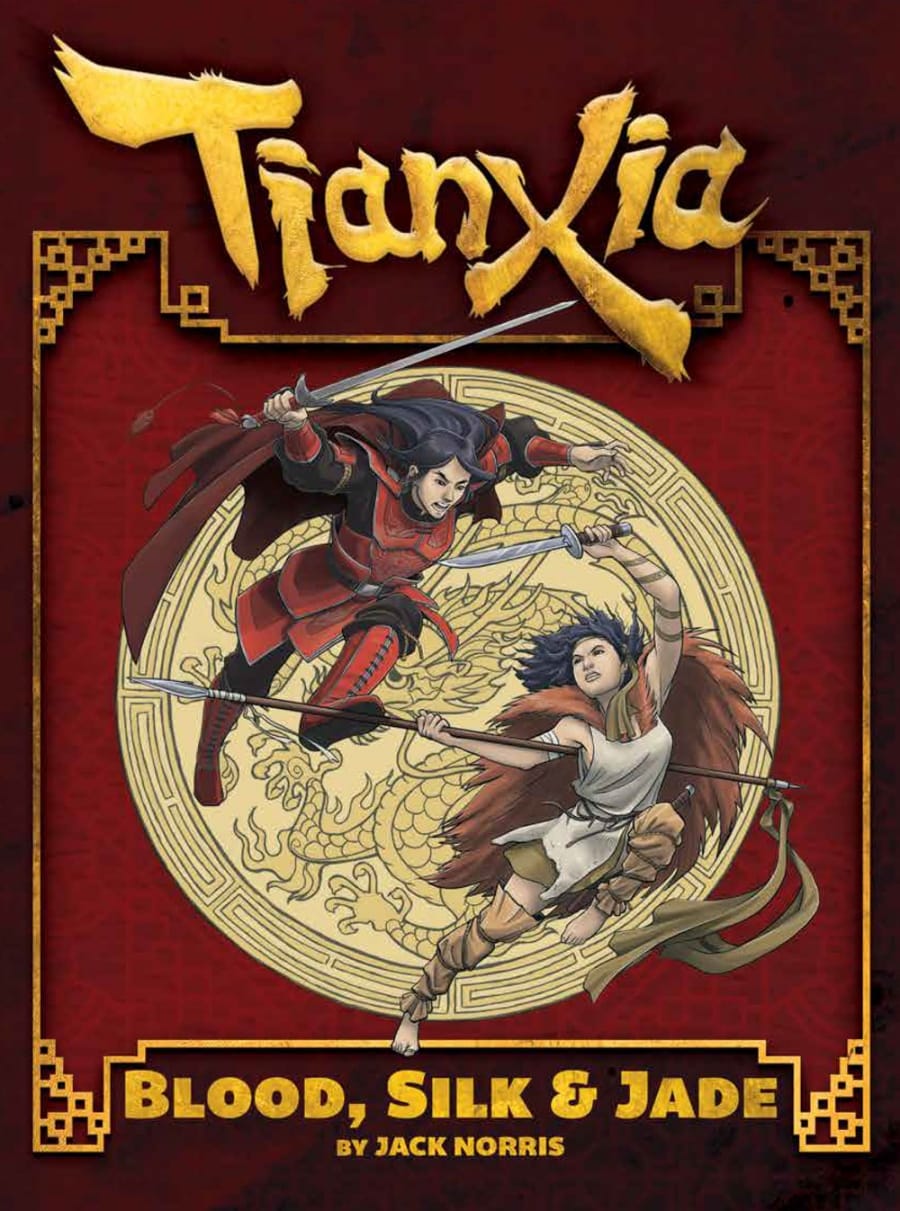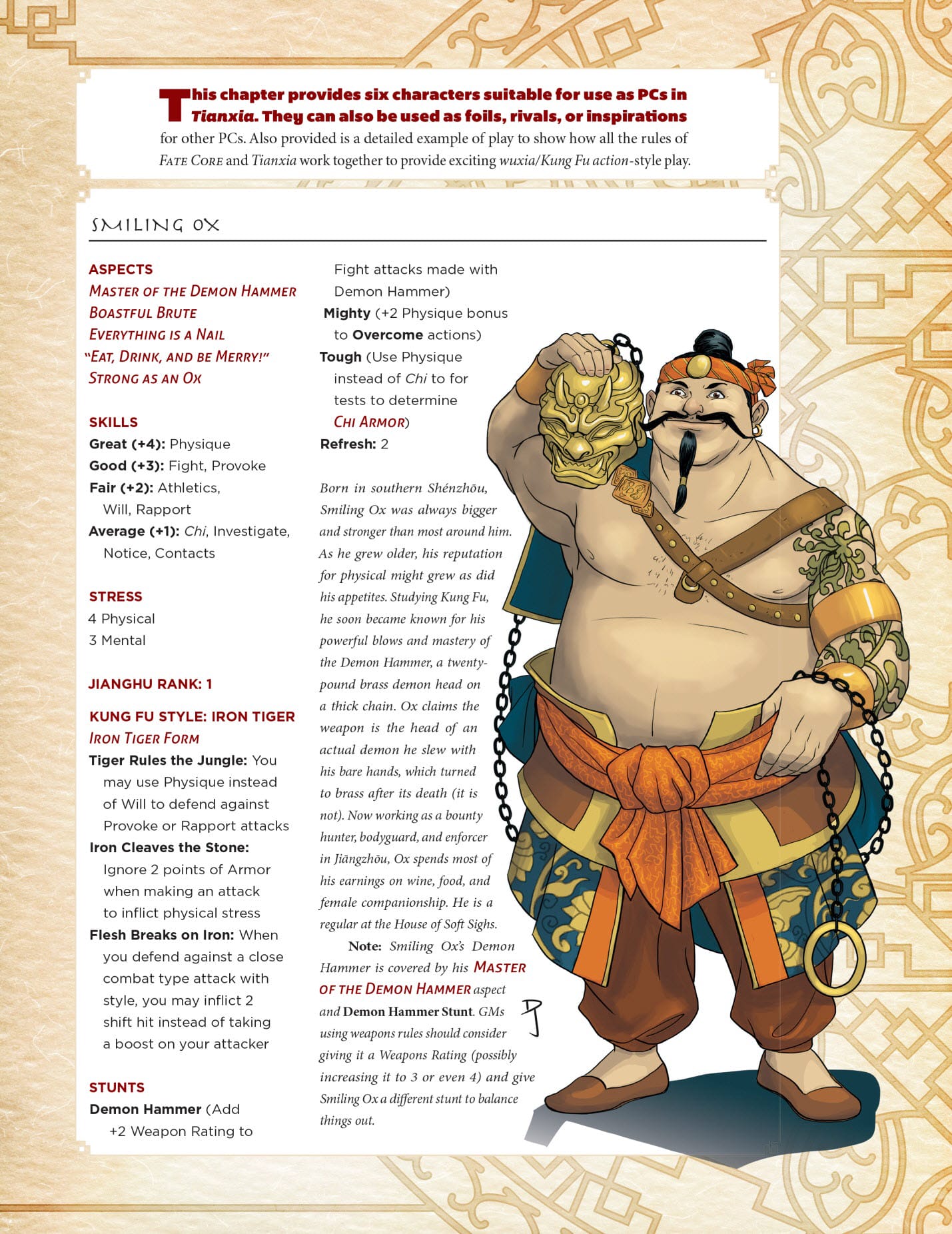The Kickstarter raised more than x3 the target goal and Tianxia looks stunning. But what is the RPG? The Wuxia flavoured, Fate Core powered, RPG is now available for purchase and you can download it today from DriveThru RPG.
Geek Native reached out to Vigilance Press and author Jack Norris. What tips and tricks did Jack have for getting started with Tianxia? Perhaps you fancy giving the game a try but you’ve never dabbled with Wuxia before? Jack kindly agreed to answer a whole series of “top three tips” questions and who better to help you run the game than the guy who designed it?
Can you quickly describe Tianxia for us? What sort of RPG and setting is it?
Sure. Tianxia is a setting and ruleset for the Fate Core system focused on wu xia/kung fu action. Its set in Shenzhou, a historic and mythic China inspired setting that features everything from Kung Fu using monks to bandit kings and so on. If you’ve seen films like Crouching Tiger, Hidden Dragon, Hero, The Bride With White Hair, etc… then you’ve got a good idea what the general feel and tone of the setting is. The name Tianxia, by the way, means “All Under Heaven” and is usually attributed to the Emperor of China’s Qin Dynasty who used the term to describe his plan to unite all of China under one empire. If you’ve seen Hero or Emperor and the Assassin, you’ve seen a version of that story.
The game uses the basics of Fate Core and builds a modular Kung Fu system and other genre specific rules around them. It’s designed to be easy to pick up but with tactical depth for those who desire it, as how you play is going to be generally more important to success than a particular build for a character.
What three things should GMs keep foremost in mind to ensure a fun and smooth Tianxia game?
I think the biggest thing is knowing and listening to your players. Is that two things actually? Yeah I think it is: cooperation and communication. It’s amazing what a little cooperation and communication can solve. Also, when in doubt? Keep the action flowing. The stuff Tianxia draws from as inspiration runs on action and dynamic plots. If you’re getting stuck or bogged down? As Doc Savage creator and writer Lester Dent used to say, “When you get stuck? Have someone kick in a door and brandish a weapon.” You don’t need to do exactly that all the time, but the principle is solid. When in doubt? Kick some ass or do something else sudden and dramatic. You and the players can smooth out the rough edges as you go. In fact, I find people just tend to naturally do that a lot of times if they’re having fun.
What three tips do you have for GMs wishing to give Tianxia the appropriate Wuxia feel rather than just another fantasy clone?
First and foremost, consume a bit of media if you’re not already familiar with kung fu action or wu xia stories. If you are, then think about the media and what you like about it and why it seems different to you. You don’t need to watch tons of it, but getting together with the players to watch a couple movies definitely helps get everyone in the mood.. The GM section of the book also lays out some tricks and ideas that might help here, such as breaking down how most relationships in Chinese media (especially action films) are defined or pointing out some subgenres to play with.
Does Tianxia have to be Wuxia in feel? How would you describe Wuxia?
Okay two part answer for a two part question. First….kinda? I mean it doesn’t need to be slavishly wu xia, but I think its hard to lose every bit of the feel as it was designed to draw from the genre. However, there’s a big difference between something like Last Hurrah for Chivalry, which is basically a traditional Kung Fu film with I think one wire work shot and something like Detective Dee and the Mystery of the Phantom Flame, which is some Sherlock Holmesean intrigue that includes stuff like a Kung Fu deer fight. Note when I say its hard to lose all of it, I’m even looking at things like Avatar: the Last Airbender, the Matrix, and at least a few of the modern superhero films and noting at least some shades of wu xia. Also, Tianxia isn’t just wu xia, but its also Kung Fu action as well. So if you like more grounded, less flashy tales that feature characters who are a bit more tied to daily life in the setting, you can totally do that with game. It’s intentionally a mash-up of two genres a lot of people understandably treat as pretty much the same, though I talk about the differences some in the book.
Which brings us to the second part, what’s wu xia? Very technically its “martial hero” or “wandering knight” stories that put larger than life characters with amazing martial arts powers and abilities into very dramatic stories against a backdrop of a secret world of martial arts and fighting societies that exist alongside but somewhat apart from the rest of civilization. More casually, it’s China’s equivalent of the Japanese wandering ronin tales, or American Westerns, or any number of “wandering heroes who do good deeds, get into trouble, and life and die by the sword” type stories. Which I think is great, since you can use other types of tales easily for fodder for wu xia/Kung Fu action style adventures.
What tips do you have for GMs preparing session notes for Tianxia? How should the game be structured?
Honestly, and I spent a fair amount of time trying to reinforce this in the game with optional rules and advice, the game can be structured a lot of different ways. I think many people are going to have an idea of what sort of game they want to run and what sort of game a setting like Tianxia’s is good for. I’m not out to tell any of those people they’re doing it wrong. Nope, my job is to give them tools and suggestions on how to do it best with the rules we provide. So if you want a hexcrawling sandbox exploration game? We define parts of the setting but intentionally leave “white space” to be filled and don’t hang anything on a metaplot. If you want long running dynastic play? We provide rules for that. Or troupe play. Or games with a particular tone or subgenre style. Ultimately, I wanted a game you could run as a one-shot with the sample PCs in the book or that could lead to dynastic multigenerational epics and everything in between.
So all that said, I’m back to the best way to prepare is to figure out what sort of game you want to run and then go for it. Same with prep. Do as much as you need to feel comfortable but not so much you’re dragging yourself down with it. My only other advice for session notes really is that having some way of easily making notes or recording significant game events is really useful. It shows you what worked and what didn’t. In my games I usually have a player volunteer to help with that, but I’ve seen people use recorders, various notetaking apps on an electronic device, or of course just old fashioned pen and paper.
 As a Tianxia GM what three things should you ask your players to do?
As a Tianxia GM what three things should you ask your players to do?
First is to have at least a bit of familiarity with the genre. Note, I find that you don’t need much and its harder these days to find someone who has never seen Crouching Tiger, Hidden Dragon or some other film in the genre than not, at least among us geeks. Of course, players don’t even need to have ever seen wu xia or Kung Fu films or TV shows, as long as they understand the basic themes and concepts. Second, communicate with you and each other what they want out of a game. This doesn’t need to be a formal stuffy declaration or anything, and a lot can be revealed simply by what sort of character they want to play. But in some way, they should let you know “I’d like the have some detective stories intermingled with all the martial arts stuff” or “I’d really like to have my own personal nemesis who I eventually have a big final battle with” or just “I’m cool with whatever you come up with, I just want to see what happens.” Note that if you know your players well enough you may know what they like already. Third, have them tell you what they don’t want. Again, this doesn’t need to be a big deal, but if there’s something that will make things not fun for them? Have them tell you.
A decent trick for those last two is to have players give you “three dos and a don’t”. Basically have them give you three general things they’d like to see and one thing they certainly don’t, No reasons or anything are even needed. Maybe a new father doesn’t want to have any adventures that feature the death or serious harm of kids, but he’d really like to eventually get the opportunity to take on a pupil, master his Kung Fu Style, and explore the setting. Maybe another player doesn’t want to deal with money in any major sense, but wants the game to feature secret societies, legendary weapons, and romance. This can work very well and be a real help to GMs, though it works best if you keep it very general and not used to plot out everything. Especially since in Fate Core if you really want some specific element to your character, you should be putting it on your character sheet as an Aspect or Stunt.
What are your top three tips for creating a memorable Tianxia villain?
First, really focus on playing the character the way he was made. You shouldn’t treat the villain as your PC, that can lead to some problems, but the best way to make a character seem memorable and organic is to play them according to their capabilities. If a player character outsmarts a mastermind villain, the villain will make other plans because that’s what masterminds do. If a character keeps foiling them, a pragmatic villain will want to do something about it to further future plans, a vengeful one will want to get even for being slighted, and a cowardly one will seek to avoid them or get someone else to deal with them. They also might have other interests and plans that don’t directly involve the PCs. Sometimes you don’t even need a plot or adventure for session, just look at what the players are doing and react appropriately as the villain. A guy with an army of minions and some serious ambitions is basically a walking game session.
Second, give them flaws, interests, and affectations and work them into play. This doesn’t need to be over the top or even prominent, but a few of these character traits go a long way towards making the villain memorable. In Tianxia Kung Fu skills aren’t necessarily affectations, but unusual techniques or weapons could be. Players might forget the nondescript bandit chief they kicked in the face five game sessions ago, but they’ll remember the beautiful bandit chief with the eyepatch and the repeating crossbow.
Third, keep it to two or three affectations. Four tops. There’s a lot to be said for giving villains cool quirks, a distinctive style, etc…but you stack too many of those up and it becomes kinda silly. Look at Bond villains for any example of how to put together a cool chain of a few affectations. The best ones have some fairly crazy elements, but only a handful. For example, Jaws has metal teeth, is huge, and doesn’t talk. That’s pretty cool. If he also collected porcelain kittens, loved opera, hated the Swiss, and…well, see where we’ve kind of lost the main thrust and went from memorable to kind of a mess? That’s something to avoid.
 Tianxia has a great stance on gender-roles and sexism. It’s clearly an issue you’ve thought about. The short of it is that the game can be played to suit the gaming group’s preferences. How can gamers take advantage of an inclusive stance on gender equality while capturing some of the sexist fuelled drama of the traditional setting?
Tianxia has a great stance on gender-roles and sexism. It’s clearly an issue you’ve thought about. The short of it is that the game can be played to suit the gaming group’s preferences. How can gamers take advantage of an inclusive stance on gender equality while capturing some of the sexist fuelled drama of the traditional setting?
We talk about various ways to do this in the book, but one of the main ways is in how the players build their characters and game. A player who builds a character with an aspect like “Father Raised Me as the Son He Always Wanted” is clearly stating that at least in her background there was some expectation of women acting and contributing to society differently than men. If the GM adds an aspect to the campaign of “All Warriors are Welcome In the Jianghu” ( “The Martial World”, the society of martial heroes and warriors) he’s implying that certain people are not welcome elsewhere, but that those problems are rarely an issue in the Martial World. Using tools like this you can tweak the game to hit these issues (or others) how you like.
Also, while there aren’t a variety of ethnic backgrounds by default in the setting, we also basically approach racism the same way. For example, the northern Ye barbarians are going to be looked at a bit strangely due to different cultures and their history of raiding traders and caravans. But they could also be hated and feared due to racism if that’s something the group wants to tackle.
Finally, what three tips do you have for ensuring that Fate Core works as well as possible with Tianxia?
One of the big ones is to really work the rules, especially in combat. Tianxia is designed with a mild but noticeable defensive bias that’s absent normal Fate Core. This is to emulate the idea that two equally matched fighters can go at it for a long time before one of them goes down. This means to triumph characters (PCs and NPCs) need to work the system. Create advantages, use stunts and Kung Fu Techniques to gain an edge, and of course use Fate Points to provide timely bonuses. That sort of play is how you represent outfighting a foe in the game, so its fairly important. Luckily with Fate Core having only four types of actions, we can pack a lot of tactics and variance without getting overly complex.
Second and Third go together, don’t be afraid to take chances and don’t be afraid to lose, Fate Core makes it hard to just get slaughtered if you lose a fight or things take a bad turn. Use that to take some chances. If it pays off? Great! If no, roll with it and keep moving. Wu xia stories are filled with heroes who lose for awhile before they win, so its even genre appropriate to take some serious lumps. We discuss some ways in the book how to use concessions, compels, and other game mechanics to help facilitate this. Tianxia’s a game where you can even die and win a majority victory under the right circumstances, and even death isn’t always the ultimate end when you’re talking the secrets of ultimate Kung Fu.
Geek Native readers may have been able to expand on this post. Scroll down to the comments below to discover what the community has been able to add.



